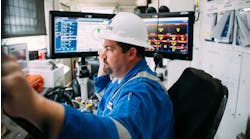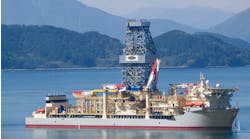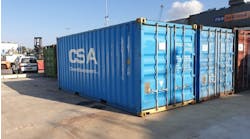BG shrugs off distractions to deliver development under budget
Neil Potter
Contributing Editor
- Location of the Armada field complex. [52,588 bytes]
- Crane barge DB102 installing the Armada integrated deck. [26,776 bytes]
- Hook-up and commissioning of the Armada platform under way using the Santa Fe jack-up Magellan. [22,518 bytes]
Agreement was reached by the licensees in April 1992. After some asset trading, BG was left with the largest share of the gas and was the only company with an interest in each block. The aim then was to bring into production in late 1996 three gas condensate discoveries made within the five license blocks on the boundaries of UK Quadrants 16 and 22.
The largest reservoir is the Paleocene Fleming Field, measuring 24 km long by 3 km wide. It was discovered by Phillips and originally known as Maggie (Phillips-style), but the name was changed when it became part of the Armada project (BG-style). The Jurassic Drake and Hawkins reservoirs are smaller accumulations lying directly below Fleming.
Combined estimated reserves of the three fields are 1.2 tcf and 70 million bbl of condensate, with field life put at 20-25 years. A deeper Triassic reservoir, Seymour, which underlies the three fields, will be developed in the future. This may contain an additional 150 bcf of gas and 10 million bbl of condensate.
Uncertainty
Before development of Armada began, an agreement was reached between the partners that fixed ownership interests in perpetuity. This obviates the need for any future re-determination.The history of the development is, in effect, a microcosm of the numerous problems facing the North Sea offshore industry in the early 1990s.
The first development plan, issued in 1992, was for two platforms, primarily due to the length of the Fleming reservoir, with a cost of £740 million. By December that year, this was modified to a single production, quarters and wellhead platform, with a small subsea facility to the north of the platform location to allow for the drilling of two to three wells in order to tap all the Fleming reserves.
By July 1993, it was decided to re-schedule the start-up date to late 1997, for reasons of economics. At this time, the first tentative steps were being taken by the industry to establish what became known as Crine, a program with the avowed aim of cutting UK field development costs by at least 30%. The Armada project team adopted many of the practices which were to be absorbed into Crine-standard specifications for some equipment and non-duplication in engineering and design. Abolition of PRT tax for new fields in the 1993 UK budget helped the finances further.
Re-assessment
Quietly and efficiently, while British Gas had to wrestle with problems of take-or-pay contracts, Ofgas, massive redundancies, splitting of the company and accusations of fat-cat salaries, re-assessment of Armada continued. This resulted in a much simpler concept of a single platform, as advances in extended reach drilling techniques meant that all three fields could be reached from the one center, thus obviating the need for the subsea facility.A 180-ton subsea template, fabricated by Lewis Offshore in Scotland, was installed in January 1995. Pre-drilling of the eight production wells (five on Fleming, two on Drake and one on Hawkins) began, using the semisubmersible Santa Fe 135, which met all BG's requirements for wells over 20,000 ft. These included a top drive system with a minimum of 45,000 ft-lb of continuous torque, three mud pumps and a high performance solids control system for use with synthetic mud.
Efficiencies
The 30-in. and 20-in. casing strings were batch set on all eight wells which, according to British Gas E&P, led to substantial efficiencies in extended reach drilling through reduced downtime. For example, a day per well was saved through the BOP being moved from slot to slot at the end of each well, rather than pulling it to the surface.Three wells - A-4 (21,681 ft), A-5 (18,690 ft) and A-8 (23,905 ft) - are extended reach. A-8, with a maximum inclination of 75 degrees, is thought to have set a new world record as the longest well drilled from a semisubmersible.
Once the platform had been installed by Heeremac in March/ April 1997, the jack-up Magellan started the well completions. Production began from two wells on Fleming - A-1 and A-3 - and from the A-2 well on Drake. There are no permanent drilling facilities on the platform. In 4-5 years, under a second development phase, a jackup will drill seven more production wells in tender-assist mode, probably one of Fleming, three on Drake and three on Hawkins.
Project costs
In April 1994, when the plan was approved by the then Department of Energy, the total cost for all phases, including future drilling, was put at £625 million. For Phase 1, the cost had been cut back to £539 million with the final figure well around £416 million. And according to Frank Chapman, managing director at BG Exploration & Production, "we expect operating costs to be among the lowest in the North Sea."The 6,000-ton jacket was built by Barmac at Ardersier, Scotland under an £11 million contract and the 10,000-ton integrated deck, a £50 million contract, by Kvaerner Oil & Gas at Methil. The living quarters module was assembled by Consafe at Burntisland, with pipeline installation handled by EMC.
Gas is transported through the CATS system to Teesside, with condensate exported through the Forties pipeline system to Cruden Bay. Topsides engineering contractor Amec and jacket designer John Brown provided post-design support to the fabricators, AOC, brought onboard the project at an early stage, handled hook-up and commissioning.
BG opted not to go for an alliance-type working arrangement, but the contractors did work together in a co-operative way. Each major contractor, through risk and reward contracts, can share in the Capex savings with the Armada partners.
Hole-life costing
A key component of all the Armada designs, says BG, was whole-life costing to achieve a correct balance between the cost of providing the facility and the ongoing price for maintaining it. An example of this with the jacket was the selection of a 100-year design life for the bottom half. This resulted in a relatively small increase in steel requirements, but also means that regular, expensive diving inspection is avoided.Five of the Armada co-venturers, Agip, Amoco, BG E&P, Fina and Phillips who together hold 93% of the field equity, will sell their gas to British Gas at an average daily rate of 225 MMcf/d and to National Power at 100 MMcf/d. The remaining partner, Yorkshire Power, will be allocated up to 30 MMcf/d, for which it is targeting the domestic market. Full gas sales agreements, executed in May 1994, cover contracts for the first five years of production. After that, further gas tranches will be sold. Wood Group Engineering was recently contracted for five years to provide modifications, front end and detailed engineering and implementation services on the platform. Logistics over the same period will be managed by Seaforth Maritime.
Problems facing UK industry in the 1990s:
- Ever increasing development costs
- Uncertainty in the gas market, with a UK Monopolies and Mergers Commission inquiry into the gas industry as well as heated exchanges between BG itself and Ofgas, the industry regulator
- Low oil prices
- Government review of the coal industry, which might lead to subsidized coal production, thereby restraining the dash-for-gas for power stations.
Copyright 1997 Oil & Gas Journal. All Rights Reserved.


